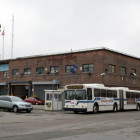Economy
Now What?
Jarrett Murphy |
In the lobby of STRIVE, an employment-training program in East Harlem, the messages are clear, stated in a bold, black font on posters that greet the overwhelmingly black and Latino clients as they get off the elevator and enter the lobby: “Please Remove Your Hats.” “Please Do Not Wear Pants Below the Waist.” “Please Do Not Wear Headphones.”Inside the classroom, says STRIVE’s chief operating officer, Angelo Rivera, attitudes are a primary target. “You have to inflict some kind of discomfort and pain so they can own up to what their issues are,” he says. “That whole attitudinal piece will make you or break you in the world of work.”But in a month of instruction, STRIVE students also get two days on civics.





